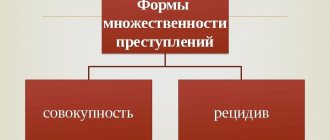Concept, signs and types of multiplicity of crimes
Multiplicity of crimes means:
- commission by a person of two or more crimes, each of which retains its criminal legal significance;
- cases of commission by one person simultaneously or sequentially, before or after conviction, of two or more crimes that have retained their criminal legal significance;
- the commission by the same person of several offenses, each of which is regarded by criminal law as an independent crime.
In theory, the following types (forms) of multiplicity of crimes are recognized:
- accumulation of crimes and recidivism of crimes;
- repetition of crimes and the ideal totality of crimes, and the real totality and recidivism of crimes are considered as varieties of repetition;
- committing several crimes a) without a previous conviction (repetition and accumulation of crimes) b) or with at least one previous conviction (recidivism, accumulation of convictions).
Some authors have proposed that a set of sentences be considered a form of multiplicity of crimes. This type of multiplicity of crimes received its name from the name of Art. 70 of the Criminal Code “Punishment based on cumulative sentences.” It sets out the rules for assigning punishment in cases where the convicted person, after the sentencing, but before fully serving the sentence, committed a new crime. In this regard, the name of this type of multiplicity of crimes should be considered unsuccessful, since the totality of sentences characterizes the way the court imposes punishment, but not an independent type of multiplicity of crimes. More precisely, this type of plurality, in contrast to the recidivism of crimes specified in Art. 18 of the Criminal Code, call it a quasi-relapse, that is, almost a relapse, close to a relapse. Another proposal: to designate in the criminal law the combination of crimes in question as repetition of crimes after a person has been convicted.
This type of multiplicity of crimes differs from recidivism (Article 18 of the Criminal Code) in the following:
- firstly, it covers the commission of not only intentional, but also careless crimes;
- secondly, a repeated crime is committed only during the period of serving a criminal sentence;
- thirdly, it covers cases of commission of crimes of minor gravity, or under the age of 18, or crimes for which the conviction was recognized as suspended or for which a deferment of execution of the sentence was granted, that is, those cases in which criminal records are not taken into account to recognize recidivism of crimes (h 4 Article 18 of the Criminal Code).
Analysis of the types of multiplicity of crimes allowed us to establish the following characteristics:
- every act forming a plurality is a crime;
- the same person has committed two or more independent crimes;
- these crimes can be committed by one act or several acts;
- any crime can be completed or unfinished (preparation for a crime or attempted crime) or committed in complicity (perpetrator, co-perpetrator, organizer, instigator or accomplice);
- acts included in the plurality entail (may entail) criminal liability, punishment and criminal record of the person who committed it.
The concept of plurality does not cover acts after the commission of which the person was:
- exempted from criminal liability on the grounds provided for in Art. 75-78, part 1 art. 90 of the Criminal Code, norms (notes to articles) of the Special Part of the Criminal Code and the act of amnesty;
- exempted from punishment (Articles 80.1, 81, 83, 84, 92 of the Criminal Code);
- convicted by a court verdict, but the criminal record has been expunged or removed (Articles 86, 95 of the Criminal Code).
In addition, the multiplicity of crimes does not take into account crimes for which there are circumstances that exclude criminal proceedings (for example, the absence of a statement from the victim in cases of private and private-public prosecution - parts 2 and 3 of Article 20 of the Code of Criminal Procedure, the absence of a statement or consent to initiate a criminal case against the head of a commercial or other organization that is not a state or municipal enterprise or an organization with participation in the authorized (share) capital (share fund) of the state or municipality - Article 23 of the Code of Criminal Procedure).
If we take the presence or absence of a criminal record as a criterion for dividing the multiplicity of crimes, then we can distinguish the totality of crimes (ideal and real) and the commission of a crime by a person with a criminal record (recurrent and quasi-recurrent).
If we take the number of acts committed as a classification criterion, then we should distinguish the ideal totality of crimes and the repetition of crimes (real totality, relapse and quasi-recidivism).
The study of signs of multiplicity of crimes and its division into types is taken into account when distinguishing and qualifying these types. We are not talking about the qualification of crimes based on their elements, but about special qualification rules for the commission of several crimes, that is, based on the totality of crimes and the recurrence of crimes. In such cases, the law enforcement officer establishes not only the presence or absence of signs of a certain corpus delicti in the act, but also other signs that are outside the scope of such a crime, but necessary for the criminal legal assessment of the act as a set of crimes or a relapse of crimes.
Along with the many crimes in the criminal law, there is a multiplicity of offenses that have criminal legal significance. The plurality of offenses is characteristic of crimes with administrative prejudice (for example, provided for in Articles 151, 151.1, 178 of the Criminal Code) and civil law (for example, provided for in Articles 157, 177 of the Criminal Code).
The General Part of the Criminal Code specifies the elements of penitentiary criminal offenses with administrative prejudice (for example, provided for in Parts 2 and 3 of Article 74, paragraph “a” of Part 7 of Article 79 of the Criminal Code) and disciplinary (for example, provided for in Part 3 of Art. 49, part 4 of article 50, part 5 of article 53, part 6 of article 53.1 of the Criminal Code). Some offenses constitute a single relapse (for example, in case of violation of public order by a conditionally convicted person - Part 2 of Article 74 of the Criminal Code) or multiple (for example, in case of systematic violation of public order by a conditionally convicted person - Part 3 of Article 74 of the Criminal Code).
What does judicial practice show under the article?
The practice under this article is extensive, since many criminals act under several articles at the same time.
Examples of cases:
- Citizen Zh. committed several crimes. First, he entered the neighbor’s home illegally, then tied him up and unlawfully deprived him of his freedom, then took away part of the property, thereby causing property damage. In addition, he hit the man on the head and he lost consciousness, causing minor injuries. The investigation arrested the criminal. Several unlawful acts were taken into account when sentencing. In total, Zh. received 5 years of arrest and a fine of 300 thousand rubles, including payment for moral and property damage and the cost of treatment of the victim.
- Citizen F., while intoxicated, beat and raped his pregnant wife, and then his 12-year-old child. As a result, both received multiple injuries. F. disappeared after the crime, but was found. When sentencing, the court took into account aggravating circumstances and the two crimes together. He received 15 years in prison.
- Citizen E. was engaged in prostitution and at the same time sold drugs to her clients. She was detained by a police officer during a planned operation. She was arrested and the case began to be investigated. As a result, for several crimes committed in total, she received 6 years in prison and compulsory labor.
What decisions are most often made under Article 69?
Defendants are often accused of multiple offenses. The greater the number of such episodes, the more dangerous the consequences for society. This circumstance necessitates the use of strict corrective measures. More often, the article makes guilty decisions, and more strictly than separately for each article.
What is the difference between a set of crimes and a sentence?
The law and amendments do not describe the concept of cumulative sentences. A conviction in this situation is used if the convicted person committed new dangerous actions after the appointment of corrective measures.
There are 3 types of aggregate sentences:
- combination with relapse;
- unification without relapse;
- combination with a set of crimes.
Consideration of acts as a whole does not affect the qualification of punishment. The totality of sentences covers the area of recidivism. The takeover rule is not allowed. Relapse is taken into account when choosing only the type of colony and is an aggravating factor.
Cumulative sentences also apply if the punishment is not carried out. The unfulfilled part includes: the full period of the suspended sentence, part of the period after parole, the time for deferring the execution of compulsory measures, the period of release due to illness. Situations are often considered when the court first applies a set of crimes, and then sentences.
Set of crimes
A set of crimes is the commission of two or more crimes, for none of which the person was convicted (Part 1 of Article 17 of the Criminal Code).
Signs of a combination of crimes:
- committing two or more crimes;
- these crimes are provided for in different articles or parts of the article of the Criminal Code;
- These crimes must be committed before the person is convicted, that is, before he is convicted.
The theory of criminal law distinguishes two types of totality of crimes - real and ideal.
By real totality we mean the commission of several acts, each of which is provided for by various articles or parts of the article of the Criminal Code. Usually these acts are committed at different times, but there may be cases when a crime is committed at the time of the commission of another, ongoing or continuing crime.
For example, a deserter who has committed theft of someone else's property is liable under Art. 338 and 158 of the Criminal Code.
An ideal totality is understood as the commission by one action (inaction) of two or more crimes provided for in different articles of the Criminal Code (Part 2 of Article 17 of the Criminal Code).
The crime is classified as a set of crimes in the following cases:
1. If the method of action is a sign of a crime, but is more dangerous and is punished under another article of the Criminal Code more severely than the main crime committed with its help.
For example, resistance provided to a representative of the authorities who is suppressing hooligan actions is not covered by the elements of hooliganism (Part 2 of Article 213 of the Criminal Code) in cases where, as a result of the use of violence, the perpetrator committed another more serious crime (Clause 9 of the resolution of the Plenum of the Supreme Court of the Russian Federation of November 15, 2007 “On judicial practice in criminal cases of hooliganism and other crimes committed for hooligan motives”).
If, during the rape of the victim, grievous harm to health was intentionally caused, the actions of the guilty person are qualified under the relevant part of Art. 131 of the Criminal Code and in conjunction with the crime provided for in Art. 111 of the Criminal Code (clause 2 of the resolution of the Plenum of the Supreme Court of the Russian Federation of December 4, 2014 “On judicial practice in cases of crimes against sexual integrity and sexual freedom of the individual”).
2. If a person has committed homogeneous actions, some of which are assessed as a completed crime, and others - as preparation, attempt or complicity in a crime.
For example, the murder of one person and the attempted murder of another, regardless of the sequence of criminal actions, are qualified under Part 1 or Part 2 of Art. 105 and according to Part 3 of Art. 30 and paragraph “a”, part 2, art. 105 of the Criminal Code (clause 5 of the resolution of the Plenum of the Supreme Court of the Russian Federation of January 27, 1999 “On judicial practice in murder cases (Article 105 of the Criminal Code of the Russian Federation”).
3. If a crime is committed that is associated with the commission of other crimes, in the absence of signs of a single complex crime, for example, murder associated with kidnapping (clause “c” of Part 2 of Article 105 of the Criminal Code), robbery, extortion, banditry (clause “z” part 2 of article 105 of the Criminal Code), rape or violent acts of a sexual nature (clause “k” of part 2 of article 105 of the Criminal Code).
A number of experts believe that these crimes should be classified not according to the totality of murder and the crime associated with it, but only according to the relevant paragraphs of Part 2 of Art. 105 of the Criminal Code, since in this case a compound crime was committed with a set of crimes taken into account by the legislator. In addition, in their opinion, recognition of a set of crimes here would mean double liability, prohibited by Art. 50 of the Constitution of the Russian Federation and Part 2 of Art. 6 of the Criminal Code.
Other lawyers argue that conjugation is not a compound crime and a legislatively recorded aggregate, since conjugation is the relationship of two independent crimes, and the aggregate is a whole that arose as a result of the combination of crimes. Murder and the crime with which it is associated form an ideal (in most cases) or real totality.
This point of view is reflected in a number of decisions of the Plenum of the Supreme Court of the Russian Federation. Thus, in paragraphs 7, 11 and 13 of the resolution of January 27, 1999 “On judicial practice in cases of murder (Article 105 of the Criminal Code of the Russian Federation)” it is stated that in cases of murder involving kidnapping, hostage-taking, robbery, Extortion, banditry, rape or violent acts of a sexual nature are classified under the relevant paragraph of Part 2 of Art. 105 of the Criminal Code of the Russian Federation in conjunction with the crimes provided for in Art. 126, 162, 163, 206, 209, 131, 132 of the Criminal Code.
4. If one crime is committed with the aim of creating conditions for the commission of another crime or facilitating its commission.
5. If the crime committed is a method of concealing another crime or a means of evading criminal liability, except in cases where this method is covered by the elements of the concealed crime.
For example, according to paragraph 2 of the resolution of the Plenum of the Supreme Court of the Russian Federation dated December 4, 2014 “On judicial practice in cases of crimes against sexual integrity and sexual freedom of the individual”, murder in the process of rape or violent acts of a sexual nature, as well as committed at the end of these crimes based on revenge for resistance shown or for the purpose of concealing them, it should be classified according to the totality of crimes provided for in paragraph “k” of Part 2 of Art. 105 of the Criminal Code and the relevant parts of Art. 131 or 132 of the Criminal Code.
The totality of crimes entails the imposition of punishment according to the rules provided for in Art. 69 of the Criminal Code.
There is no totality of crimes if:
1. A single complex crime has been committed (composite, continuous, ongoing, with alternative, repeated or systematic actions).
For example, a person committed theft of property entrusted to him using his official position. The deed is fully covered by Part 3 of Art. 160 of the Criminal Code and additional qualifications under Part 1 of Art. 285 of the Criminal Code is not required (clause 17 of the resolution of the Plenum of the Supreme Court of the Russian Federation of October 16, 2009 “On judicial practice in cases of abuse of official powers and exceeding official powers”).
2. The crime committed is provided for by general and special norms, since in this case there is their competition.
3. One crime has been committed, the signs of which are provided for in several parts (paragraphs) of the same article of the Criminal Code of the Russian Federation.
For example, murder, qualified under several points of Part 2 of Art. 105 of the Criminal Code (clause 17 of the resolution of the Plenum of the Supreme Court of the Russian Federation of January 27, 1999 “On judicial practice in murder cases (Article 105 of the Criminal Code of the Russian Federation)”). In case of committing theft, robbery or robbery under aggravating circumstances, provided for in several parts of Art. 158, 161 or 162 of the Criminal Code, the actions of the perpetrator in the absence of a real set of crimes are qualified only under that part of the specified articles of the Criminal Code for which a more severe punishment is provided (clause 17 of the resolution of the Plenum of the Supreme Court of the Russian Federation of December 27, 2002 “On judicial practice in cases about theft, robbery and robbery").
4. The acts committed by a person fall under the signs of successively completed stages of preparation for a crime or attempted crime.
5. One crime develops into another more serious crime or is an intermediate stage in the commission of the next, more dangerous (serious) offense. The act should be qualified only under the article of the law providing for liability for a more serious crime.
6. A person, being the perpetrator of a crime, at the same time performed the functions of an organizer, instigator or accomplice. In this case, it is customary to reflect only performing actions in the qualification formula.
7. Two or more crimes are provided for in the articles of the Special Part of the Criminal Code as a circumstance entailing a more severe punishment, that is, they are considered as a single crime (Part 1 of Article 17 of the Criminal Code).
8. A person, in order to conceal the theft of someone else’s property, destroyed it.





